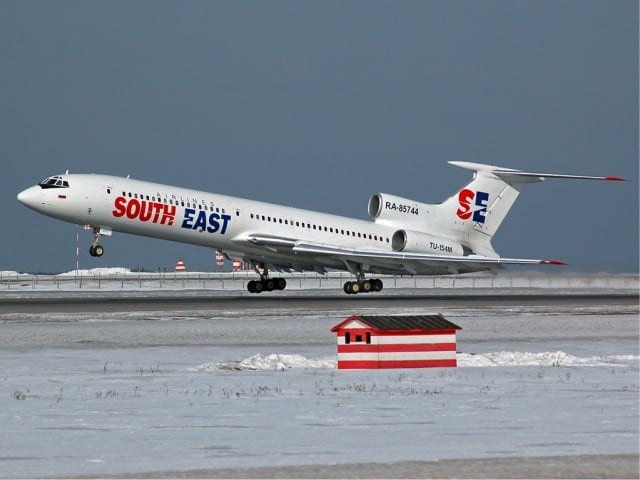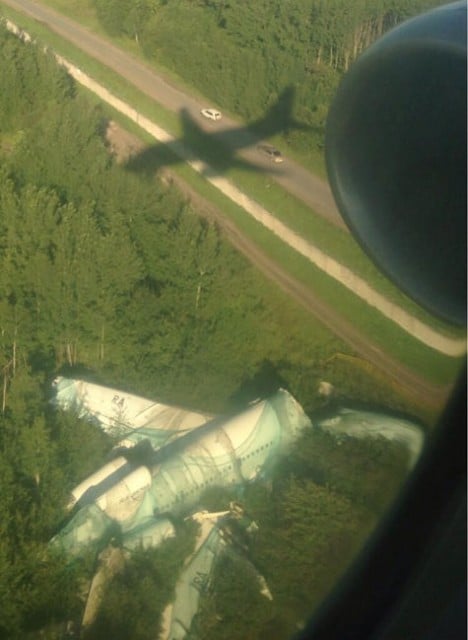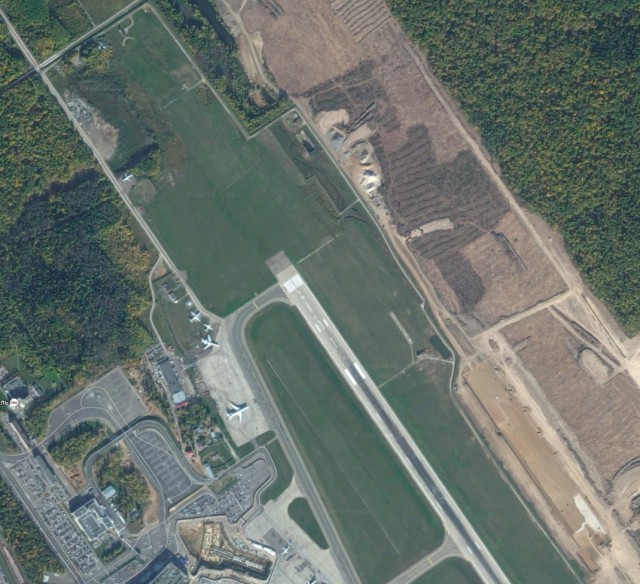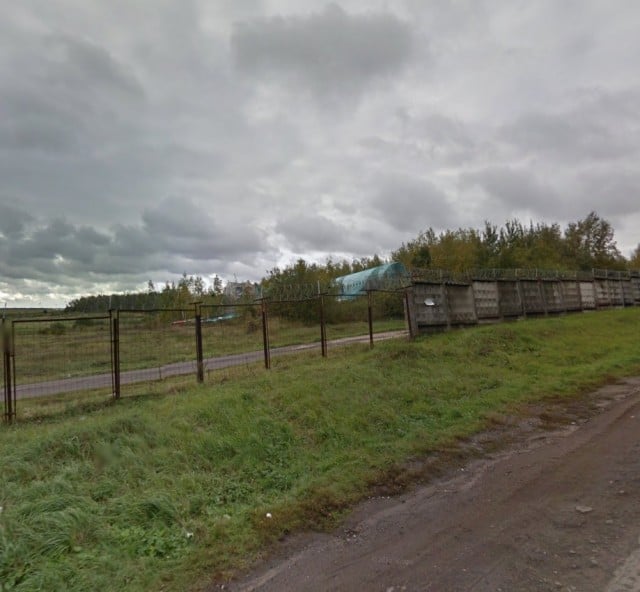Shocking CRM led to that Abandoned Tupolev at Moscow Airport
This story started, as so many do, with an interesting photograph posted to Reddit.
I was curious, and decided to investigate the accident. The sequence of events that led to the wreck was a lot more fascinating than I expected.
The airline was initially set up as the Makhachkala division of Aeroflot in 1927. In 1994, the Makhachkala division became the Makhachkala Air Enterprise following the break-up of the Soviet Union. In 1996, the airline became Dagestan Airlines.
Dagestan Airlines flight 372 was a scheduled flight from Vnukovo International Airport, Moscow to Uytash Airport, Makhachkala in the Republic of Dagestan. On the 4th of December in 2010, the flight held 163 passengers, five cabin crew and four flight crew.
The captain had 17,500 hours with 10,000 hours on type and 8,500 as commander. He was the pilot monitoring. The pilot flying was the first officer, who had 3,470 hours with 1,150 on type. The flight engineer had 8,750 hours with 1,750 on type. The navigator had 3,400 hours with 1,400 on type.
You would think it was safe to say that they knew what they were doing.

The plane was a Tupolev Tu-154M, a three-engine aircraft designed in the 1960s and last modernised in the 1980s. The aircraft that day was built in 1992 and had been completely overhauled the year before the accident (2009) and met all relevant European safety standards.
The flight crew landed the Tupolev at Vnukovo at 12:23 local time.
Post-flight inspections and pre-flight preparations were all normal. There were approximately 19.5 tons of fuel on board, plenty for the flight. Conditions weren’t optimal though. The runway was wet with wet snow.
The weather was awful. There were two frontal systems moving from west to east with a trough between them. Winds were forecast at 150-180 km/hour (80-100 knots, 95-110 mph).
At Moscow, snow and freezing rain were falling with a cloud base at 150 metres (500 feet). A Significant Meteorological Information weather advisory (SIGMET) was issued advising of icing from the surface to 4,000 metres (13,120 feet) with turbulence above 9,000 feet. A weather balloon in the local area measured winds at 50 km/hour (27 knots) at 2,500-3,300 feet (800-1000 metres) which increased to 255 km/hour (188 knots, 160 mph) at 29,500 feet (9,000 metres).
The scheduled passenger flight to Uytash, Makhachkala departed Vnukovo Airport normally at 14:07 local time.
As the aircraft climbed through Flight Level 164 (16,400 feet or 5,000 metres), the flight engineer initiated a manual fuel transfer, transferring fuel from one tank to another to even out the balance. The aircraft continued the climb and about three minutes later, the fuel switch was set back to automatic. As they climbed through 25,000 feet (7,700 metres), the flight crew noticed that the captain’s attitude indicator (artificial horizon) showed a different bank angle from the first officer’s. They discussed the issue but it was not particularly a cause for concern.
About a minute later, a fault message illuminated showing P Fuel (fuel pressure issue), followed by alarms ENG FAIL for engines number three and number one.
The crew reported problems with the engines to air traffic control at 14:20. They requested an immediate return to Vnukovo.
A minute later, the number three generator dropped off line, followed by the number one generator. The engine speeds of both engines dropped to 30% and then shut down.
The crew reported that their engines had failed, along with the generators and navigational equipment. The dispatcher recommended an emergency diversion to Moscow’s Domodedovo airport, 80 km north of the aircraft’s position.
Two minutes after engine number three failed, after the aircraft had begun its descent, engine number two began to spool down and generator number two dropped offline.
All three generators were now off line. Both attitude indicators failed.
The flight crew diverted to Domodedovo; however they did not appear to go through the checklists to deal with the emergency situation they’d found themselves in.
During the approach, the number 2 engine and the AC power was restored, giving the aircraft a much better chance at a safe landing. However, the crew did not appear to take advantage of this reprieve.
The AC power restored the navigation system, but none of the Domodedovo frequencies were dialled in, although they should have entered the frequencies for the ILS (Instrument Landing System) and the VOR (VHF Omni-directional Radio Range, a type of short-range radio navigation system for aircraft).
The gyros, which supply bank and pitch angle information, would have become misaligned as a part of the power outage. However, once the power was restored, the gyros would stabilise and could be caged (by pulling out a knob to restore the gyroscope to an erect position), which would restore the gyros’ functionality. This was clear on the checklist, including the instruction that, if the gyros did not cage on the first attempt, try again. The crew never tried.
The procedure for a single-engine landing on the three-engine aircraft was to set the flaps at 15 degrees for landing; however the flight crew extended the flaps to 28 degrees.
The Tupolev broke through the clouds at 500 feet, finally gaining visual contact to the ground. The aircraft was two minutes from touchdown and far to the right of the centreline of runway 32. The flight crew turned left, until they were almost perpendicular to the centreline. Almost at the threshold, they crossed the runway and overflew the airport and then 60 metres above the ground and 500 metres off of the centreline, they swung right to line up with the runway.
Amazingly, after these manoeuvres the aircraft touched down on runway 32 about 88 metres (290 feet) to the right of the runway centreline. The Tulopev 154 requires over 2,000 metres (6,500 feet) to land on a dry runway. Unfortunately, they were only about 350 metres (1,150 feet) from the (soaking wet) runway end and travelling at 248 kilometres per hour (131 knots, 154 mph) with a vertical acceleration of 2.25g.
They veered across the runway and continued down a dirt track used by security vehicles. The nose gear first touched down 60 metres (200 feet) past the end of the runway. About 100 meters (325 feet) further, the nose gear touched down again, leaving fragments of the nose gear and the nose cone behind.
In an usually scathing analysis, the Russian Interstate Aviation Committee (MAK, the supervising body overseeing aviation) said that a pilot must have certain skills to perform a visual approach and landing. As there was plenty of time, they said, to align the aircraft with the runway and touch down safely after breaking through the clouds, the landing clearly demonstrated that the first officer did not have the skills required to be a pilot.
Ouch.
In any event, the aircraft continued, leaving a trail of snow, dirt and debris in its wake, until it struck a three-metre (10-foot) earthen mound and broke up into three parts. The nose continued on to about 9 metres (30 feet) from the perimeter fence, 60 metres (200 feet) to the left of the centre line and about 1,175 metres (3,900 feet) from the first touch down point.
Accident: South East T154 at Moscow on Dec 4th 2010, two of three engines out in flight
The aircraft received substantial damage: the fuselage split in two between frames #32 and #34, the nose section was flattened in the vertical direction with the technics compartments #1 and #2 and the radome destroyed, cockpit floors and bulkheads destroyed with the navigator and flight engineer seats dislocated, nose landing gear collapsed, floor frame in passenger compartment #1 destroyed, stringers of rear fuselage showing significant deformations, right wing separated from the aircraft, the left wing fractured at rib #32 with separation of the wing tip, the left main gear collapsed.
There were two fatalities. A passenger in seat 1E was crushed by the aircraft (“mechanical asphyxia from compression of chest and abdomen by a heavy blunt object, possibly part of the cabin”) and the passenger in seat 3B died of a heart attack. Six crew, including all four flight crew, and 33 passengers received serious injuries. 53 passengers sustained minor injuries. The Tupolev 154 was deemed damage beyond repair.
At the time of the tragedy, the lead prosecutor said that preliminary results pointed to a bird strike, because what else woiuld cause all three engines to fail. But within a day, the investigators had come to the conclusion that it was a fuel issue. They swiftly ruled out poor fuel quality and the wreckage site showed that there was fuel on board.
The problem began when the flight engineer initiated the manual fuel transfer as they climbed out of Vnukovo. No one noticed that he had accidentally turned off the fuel booster pump, which meant that the level of fuel going to the engines fluctuated. There had been previous instances of the fuel booster pumps inadvertently turned off on that model of Tupolev, although never before with such catastrophic results. The engines went out one-by-one as the result of simple fuel starvation.
As if that weren’t bad enough, the four flight crew responded completely inappropriately to the situation. The Interstate Aviation Committee (MAK) specifically called out the flight engineer, who shut down engine #1 before the captain had confirmed, and then attempted to shut down engine #2. The report described him as “reckless”, saying that his only coherent action was when he reconnected generator #2 which restored the AC power.
But as we saw above, the return of the flight and navigation systems was largely ignored by the flight crew, and they did not follow the appropriate (or indeed any) checklists as they came in to land, even though they now had full power and one engine back. The captain was called out for lack of leadership. The flight crew, said the report, took “independent but not always accurate” actions, all trying to solve the situation on their own rather than working as a team using emergency procedures. This was a direct result of insufficient training at the airline, both in CRM and dealing with emergency (engines out) and complex (the landing) scenarios.
The report was released in September 2001 and concluded that the cause of the accident was the flight engineer shutting off a fuel pump but that it was more than possible to land the aircraft safely despite the loss of the engines. However, the flight crew had not reacted appropriately to the loss of engine power and not followed procedures for landing with two engines out. The report made it clear that the crew had not been sufficiently trained to deal with the situation.
Four years later, the flight engineer was found guilty in court for under the criminal code, for violating safety rules of transportation and air travel, which led by neglect to the death of two or more people. He was given a suspended sentence of 3 years.
So why is the aircraft still there? Well, generally it’s the airline who has the responsibility of removing the wreckage from a crash site. Some of the aircraft internals may still be useable and often they’ll want to analyse the wreckage for their own internal investigation. However, Dagestan Airlines had their Airline Operator’s Certificate revoked in 2011 after the final report was released. The investigation found counterfeit parts installed on the aircraft, along with significant violations and systemic weaknesses at the airline relating to training, maintenance, work and rest hours along with other issues. During the year of the investigation, ramp inspections found “gross violations of flight safety” to which the airline management was slow to respond. A final audit of the airline was performed which showed that no progress had been made towards resolving these issues. Investigators concluded that Dagestan Airlines were unable to correct the systemic weaknesses in the airline and thus the airline “posed a direct threat to the life and health of its passengers.”
This means that now, there is no one with the responsibility of clearing the aircraft from the site and so it sits, gently gathering rust, as a reminder to the flights inbound to Domodedovo of how quickly it can all go wrong.












Interesting read as usual.
One thing though, you haven’t explained what CRM is (I presume Crew Resource Management from a quick search). You usually pitch your abbreviations at the right level for someone with an interest but not detailed knowledge of aircraft operations.
Crew is sometimes interchanged with Cockpit, depending on the source. In general, it relates to proper, focused, complete communication among the flight crew, and also following documented procedures in normal flight as well as in emergencies.
Argh, I replied to this comment at the time and apparently posting from the dashboard (instead of on the website properly) isn’t working. Sorry for my silence on this.
Adrian, you are right to call me on that; I do want the articles to be readable without having to look things up and I missed that one.
Brian, thanks for filling in!
Fake parts seem to be appearing in some incidents – is there a process or formula in place that is supposed to eliminate this possibility? Interesting aspect on the pilot training – they hadn’t been trained sufficiently to deal with the incident. I can understand that there may not be perfection in training although I do feel that engines out/engine restart is basic stuff such as engine fire would be! Am I wrong?
There are processes; theoretically it shouldn’t happen any more because everyone from the buyer to the engineers should know what to look for. But where there’s a willl…
Training issues often crop up, where somehow the gap in training just hasn’t been spotted. This is the worst such case that I’ve seen in a while: http://fearoflanding.com/accidents/accident-reports/a-unique-occurrence-turning-an-incident-into-a-crisis/
The Tupolev design should include an alarm for switching off something as vital as the fuel booster pumps! I suppose it’s a moot point now anyway, since there aren’t many Tupolevs flying nowadays! :(
This statement made me really angry:
“…the landing clearly demonstrated that the first officer did not have the skills required to be a pilot.” And this sort of arrogant ‘water cooler discussion’ added exactly what to the final report?
It’s likely that the first officer was overwhelmed by the combination of having little to no assistance from the crew, and the unprecedented circumstances of have just one engine! The first officer did his best in the awful circumstances he was under. It’s just spiteful to blame him like that!
Maybe they tried it in a simulator and were successful? Well they didn’t have to worry about having several tons of aluminium and jet fuel threatening to explode into a deathly fireball if they got it wrong! I think the FO did a good job, given the circumstances!
One of the points in the accident report was that this was not the first time that the pumps had accidentally been turned off in this model.
Wasn’t the reaction from the Russian Interstate Agency “UNusually scathing?”
Perhaps the co-pilot was being a bit too much criticized, it would seem, reading all this, that the captain failed completely in his duty to monitor what was happening and initiate corrective action.
CRM: indeed Crew Resource Management, is now a major major major item in airline crew training. And indeed, it would seem that the airline concerned did not have a clue !
Nevertheless, with more than 3000 hours and 1100 hours on type, ANY First Officer should have been able to do better. But what I do not read here: the problem may well have been made worse by a culture in the former Soviet Union. All pilots in the “old days” were part of the Air Force, creating a militaristic hierarchy even in the civilian airlines. Even after the break-up of the Soviet Union, the old ways would not have completely disappeared. Meaning: Nowadays in aviation, if a captain fails to respond adequately to an emergency situation, the F/O is trained to challenge him or her. In an air force, a junior officer does NOT challenge a higher rank. That may still have created an atmosphere of “do as you are told”, even if the pilots at the time were civilians only.
I remember seeing this attitude of ‘the superior is always right’ in an accident report elsewhere in the last year or 2; I think it was a crash involving one of the Asian airlines. I suspect it is still an issue in many cultures as well as those with a military background.
On the humorous side, a bit late but perhaps someone may find this funny (not an accident, fortunately):
Many years ago on a small aerodrome in the Netherlands a Cessna 172 was taking off. It was at the time owned by the flying club of pilots of the national flag carrier and based at the airline’s main base.
The Cessna had four experienced captains on board. They had made a landing at the small aerodrome for some take-off and landing practice. At the main airport which was the home base this would have been far more costly in landing fees. The little grass strip (600 m.) was uncontrolled which would allow for easy changes of crew.
The 172 fuel supply could be channeled either from left- or right tank or both by a selector on the cockpit floor between the front seats.
The procedure was to taxi on one, do the pre-flight run-up on the other and take off on both.
I happened to witness the take-off, which was totally normal until shortly after getting airborne the aircraft obviously lost power and rapidly lost altitude. With a sigh of relief the people watching from the flying club the engine picked up again, cleared obstacles and resumed its climb.
After they landed for the next change of pilot, they sheepishly admitted that after completing the run-up the tank selector had accidentally been placed not in the “both” but in the “off” position.
Imagine, FOUR pilots all simultaneously trying to grab the selector to turn the fuel back on !